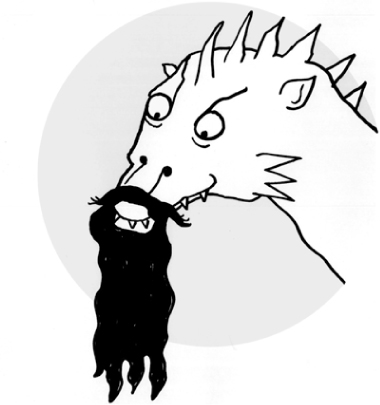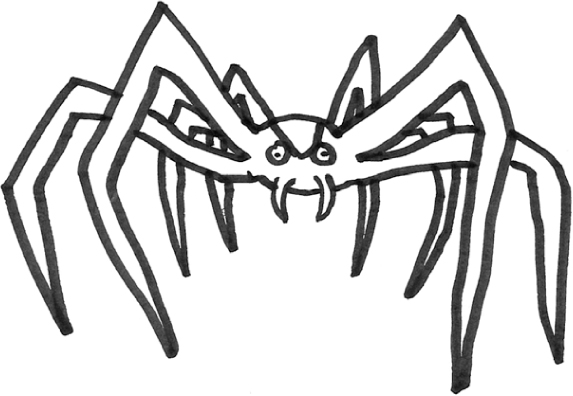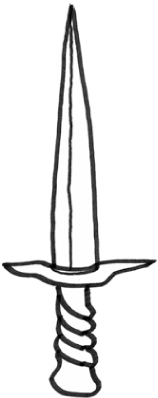CHAPTER 3
WEAPONS OF WESTEROS–A (BATTLE) FIELD GUIDE

 Swallows & Antidotes, or, Another
Swallows & Antidotes, or, Another 
Man’s Poison, or Quick! The Antidote!
Ah the Game of Thrones deaths by poison! A source of misery for some and joy for others. GRRM has given us some wonderfully juicy descriptions of the preparations and effects of toxins in the Known World, and we have poison to thank for that strong contender for everyone’s favourite death scene–Joffrey getting his come-uppance. The particular poison that does for Joffrey is called The Strangler. Oberyn Martell, long-skilled in the ways of ‘It must’ve been something he ate…?’ describes the process of making this lethal potion from a rare plant that grows across the Jade Sea, noting that it makes the victim’s face turn purple. Well, yes, we all enjoyed watching that.
But in the world of Game of Thrones, magic can be used to fight the most lethal of poisons. This is not the first time that we have encountered The Strangler–remember when King Stannis’s elderly Maester Cressen attempts to do away with the Red Sorceress Melisandre by slipping the poison into her goblet of wine and proposing a toast to the Lord of Light? Prepared to give his own life to protect his Lord Stannis from the Red Woman’s influence, Maester Cressen takes a big gulp of the poisoned wine and Melisandre delicately, but decisively, follows his lead. The Strangler quickly seizes hold of Maester and within moments he lies bleeding from the nose and mouth. For all his learning, Maester Cressen has no way of withstanding his own concoction. But the last thing he sees as the poison violently overcomes him is Melisandre’s serene, untroubled face. The strange blood red ruby choker at her throat throbs with light as it purges the poison out of her body. (Her choker can do even more than that, as we know from seeing Mel without it on.)
The idea of precious jewels protecting you against deadly toxins was wildly popular during the Middle Ages. While death-by-poisoning might be a mercifully rare occurrence today, it was a common fear in medieval times. Certainly, we know how seriously kings and queens took the threat of poisoning. Elizabeth I, now celebrated as ruling over England during a great flowering of culture and commerce, wasn’t universally popular in her day. She could easily have appeared in the Tudor equivalent of Buzzfeed’s ‘10 Monarchs Everyone’s Trying to Poison’, with numerous bizarre plots to kill her being recorded. In one Oberyn Martell-worthy episode, several members of her court arranged for a lethal poison to be smeared on her horse’s saddle. However, one of the poisoners confessed all, prior to the queen’s daily canter, and the conspirators ended up spending time in the Tower. Both Elizabeth and horse emerged unscathed.

The inventiveness of such poisoning plots was matched only by the bizarre beliefs about how to detect and deal with lethal potions. Edward VI had a ruby and sapphire encrusted toothpick that he believed would ‘sweat’ if touched by poison. Staying with the Tudors, many believed that diamonds were so powerful they didn’t even need to be in the mouth to ‘warneth of venime’ and that just popping them under ‘the left arme pit’ would do the trick. Similarly, it was said a sapphire had ‘so contrary a nature to poisons’ that if you put one in a glass with a spider, the spider would die.
Bezoars–from the Persian word for ‘antidote’–are calcified deposits that can develop in the stomachs of both animals and humans (if you do happen to get one, the recommended treatment is to drink bucket-loads of Coca-Cola to dissolve them). They were once seen as highly prized cures for all poisons. Elizabeth I kept one on a bracelet, with a contemporary description of her jewels noting that ‘The most parte of this stone is spent’, suggesting that it was used on a regular basis. If you couldn’t get your Middle Age hands on a bezoar then the alternative was a unicorn horn. These precious objects–actually the horns of narwhals brought back by sailors from the edge of the Arctic oceans–were seen as the best way to detect poisons. The same is true in Westeros, where the horns of narwhal-like creatures from the Lands of Always Winter are passed off as unicorn horns, as no-one dares to travel to the island of the Skagosi where actual unicorns are to be found. In our world, stories were told of unicorns dipping their horns into ponds and causing all of the muck and unpleasantness to magically rise to the surface, leaving the water clean and pure. Much prized, once again Elizabeth I had at least two pieces of horn, whilst Mary Queen of Scots also had one.

Of course, all of this sounds fantastic, but did they actually work? Well, when it comes to unicorn horns, er, no. But with bezoars, there is good reason to be less sceptical. One of the forefathers of modern surgery, Ambroise Paré was curious and decided to conduct an experiment. Paré was the barber surgeon to several French kings, which gave him easy access to a palace or two. In 1567 a royal chef was sentenced to hang for stealing silverware, but Paré instead persuaded the man to be poisoned and then given a bezoar ‘for science’. Unfortunately, the experiment was a complete failure and the chef died a painful death. But more modern-day investigations suggest that both the chef and Paré were unlucky. When a bezoar is immersed in a solution of arsenic the toxic compounds arsenite and arsenate (worst twin names ever) can react with it and become harmless. Although if your drink doesn’t contain arsenic, then you’ve just chucked a lump of partially digested gunk and hair from an animal’s stomach into your glass for nothing. You win some, you lose some.
 Death by Sword
Death by Sword 
Ice is the ancestral greatsword of House Stark. Its dark, smoky Valyrian steel blade is wider than a man’s handspan, and it stands taller than Ned’s true-born son, the teenaged Robb Stark. Ice’s spell-forged steel has held its edge for 400 years, a replacement for an even older sword of the same name. But ye olde sworde is no whimsical antique gathering dust above the fireplace. Because Valyrian steel is relatively light, it is possible that the Starks have wielded the mighty Ice in battle at some point, though we get a proper look at it first in Ned’s hands as he uses it to dispense justice to a deserter from the Night’s Watch (a sworn brother who has taken the black but now stands accused of separating himself from his vows, so we watch Ned separating his head from his body).

It’s traditionally a highborn person’s right to insist on trial by combat (with or without a self-appointed champion) if they’re accused of a crime. The gods then decide on your guilt or innocence, which means it doesn’t particularly matter how good a fighter you or your champion are. Nevertheless, sword practice is a big part of life, just to be on the safe side.
But despite all the practice, the Starks don’t have a great deal of luck with sword fights, frankly. Ned inherits the sword Ice after the deaths of his father Rickard and older brother Brandon at the hands of then Targaryen ruler, Mad King Aerys. Coming into conflict with Aerys, who accuses him of treachery, patriarch Lord Rickard Stark duly requests trial by combat–he’s a great swordsman. But this only works so long as everyone sticks to the rules. Aerys decides–somewhat unsportingly–that fire will be his champion, and proceeds to roast alive the Stark patriarch in his armour over a blazing pyre as the royal court looks on.
Meanwhile, Rickard’s son Brandon has been brought into the throne room with a noose around his neck and a sword that could cut his father down placed just out of his reach–Brandon strangles himself to death trying to reach it. Oh Mad King Aerys! (The clue is in the name…) In A Dance with Dragons, we learn that excellent swords-man Brandon Stark has told his lover Barbrey Ryswell that he hones his sword so that it is sharp enough to remove a woman’s pubic hair. (N.B. Do not try this at home.) Suffice to say Brandon’s untimely death at the hands of the Mad King means that his line of feminine depilatory products never really got off the ground.
Ned Stark is also denied any kind of trial by combat, and ultimately endures a surprise public beheading with Ice, his own ancestral sword. Those who live by the sword die by the sword too. But not always as they would expect.
 Death by Sword-Fighting Wounds
Death by Sword-Fighting Wounds 
Even if you win a sword fight, it can still cost you your life. An injury that became infected was a common cause of death in societies without antibiotics or a strong understanding of how to keep a wound clean. General life advice would include, don’t fight Oberyn Martell, the Dornish Red Viper, who earned his nickname after a duel to ‘first blood’ as a teenager. After inflicting a minor wound, he was declared the winner but, unknown to his opponent, he had hedged his bets by using a sword daubed with poison, so his opponent’s wounds festered and eventually killed him. But even a mere flesh wound that literally is a mere flesh wound can be the death of you. Just ask Khal Drogo, who sickens greatly after sustaining a slight wound after otherwise effortlessly winning a fight, or The Hound, left to (almost!) die on a hillside after a minor wound that didn’t really concern him putrefies.
Up until the late Middle Ages, it was widely believed that diseases of many different stamps were caused by bad, smelly ‘contaminated’ air or miasma that circulated, particularly at night. But in 1546, the theory of germs getting into a wound and causing infection and possibly death was first mooted by Veronese poet and physician Girolamo Fracastoro, who proposed that it was tiny organisms, or ‘spores’, that carried the contagion. (A rather grand portrait of Fracastoro painted by Titian hangs in the National Gallery in London today. The painting was said to be given as a payment for treating the artist for syphilis.)
By the end of the 19th century in our world, germ theory was rapidly gaining acceptance. So much so that it gave a curious twist to a duel fought between two high-born aristocrats. In 1892 in Verduz, Liechtenstein, Princess Pauline Metternich and the Countess Kielmansegg had a disagreement over flower arranging. The two had never exactly been bosom buddies, but after this latest spat, they took the surprising, though not entirely unheard of, decision to arrange a duel. This was a proper, highly regulated affair, with a pair of seconds (also female). And the medical professional on hand was, unusually for that time, also a woman–Baroness Lubinska.
Lubinska liked to keep abreast of new medical developments and was a relatively early adopter of the strictures recommended by an acceptance germ theory. If you’re injured in a duel by an opponent’s sword on a clothed part of your body, their sword could easily catch a bit of your clothing and jab it right into the wound, which could result in sepsis, or ‘blood poisoning’ setting in. The Baroness’s solution was proposed and agreed–in order to minimize the dangers of infection, the Princess and the Countess would both duel topless. And all at once a fight over the best way of displaying your knockers goes from being not very Game of Thrones, to very Game of Thrones indeed.
 Warrior Women
Warrior Women 
Yara ‘Asha’ Greyjoy, Brienne of Tarth and Arya Stark are three of the fiercest fighting women in all of fantasy literature. Warrior women thrive in the Seven Kingdoms. But in the real world, the role of females in combat situations is more controversial. ‘Should women serve in war?’ is seen as a hot topic for television debates, news bulletins and talk shows. And the generally accepted view is that it wasn’t until the 20th century, when women had achieved political agency, and started working outside the home, that it became acceptable for females to fight in the armed services.
As it turns out, warrior women have been around for longer than you’d think. And there are plenty of parallels between the women of Game of Thrones and famous female fighters in history.
Yara Greyjoy, Theon’s sister, is a high-ranking member of the Iron Born, whose culture bears certain striking similarities to that of the Vikings. In the absence of her brothers, she is something of an oddity in her society, allowed to live a more typically ‘masculine’ existence by her father, the Greyjoy leader. So much so that she briefly hopes to become his successor and the leader of the Iron Born.

If we picture a Viking fighter, we probably picture a man, probably in one of those annoying horned helmets–which they never wore IRL (apparently). This would almost certainly irk Freydís Eiríksdóttir, anti-heroine of the Viking sagas, and daughter of that other notable Viking ass-kicker Erik the Red. According to the Sagas, Freydís made it her mission to become a morally compromised fighter who you would not want to cross. In one story, for example, we witness the moment she, and some male Viking comrades, have come upon an encampment of enemy women. The men don’t know what to do with them. ‘Kill them!’ instructs Freydis. And when no-one listens, she rolls her eyes, fetches an axe and proceeds to demonstrate that a woman can commit what we’d now refer to as heinous war crime every bit as well as a man can.
Later, pregnant, she sails to the New World in command of her own men, aboard her own ship. Her Viking party encounter some native Americans and retreat in fear. Freydis is appalled at their cowardice and–eight months gone by now, so possibly slightly less handy with an axe–makes a terrible war cry, brandishes her sword about, and then, finally, pops one of her breasts out. The native Americans are duly terrified at this last gesture, and flee.
One has to ask–why did her breast have this effect? Was it a bit like on Friends when Monica flashes Joey? Was it merely the audacity of the gesture that bought time for the embattled Vikings, or was there something quite scary about her breast–could it be mistaken for an angry shark? Or had she drawn something weird on it? (No, of course not. No-one ever does that when they’re a bit bored. Certainly not.)
Someone I’ve Always Meant to Get Around to Reading, who is often described as the Father of History, the Greek writer Herodotus speaks of a race of Amazons: free wheelin’, fightin’ and hollerin’ women who fought and shot arrows from horseback. Imagine the Dothraki Khals, but with Khaleesi instead. Or Lyanna Stark, who is described as such a fine rider that she must be ‘half horse’ herself. (Though dead before the timeline of the show and books begins, Lyanna haunts those she left behind, and her secrets may yet turn to influence who finally wins the game of thrones.) Until relatively recently our classical scholars chuckled indulgently at these stories. And Herodotus also set the precedent for Classical male writers discussing female fighters and being weirdly obsessed by their chests. Seriously–I have been reading up on this stuff and Guys! You need to give the constant ‘but what happens with their boobs while they’re fighting, eh?’ talk a rest–it’s not as interesting as you think. Really.
Read historical authors on women fighting! They’re prone to sidling up to you on any pretext:
‘Reading about some women?’
‘Yes–really enjoying this bit.’
‘Well, if it’s a women bit, I expect you’ll be wanting to know what their breasts are up to?’
‘Not really. I have my own; you get used to them after a while.’
‘Let me tell you about her bosom, which—’
‘Enough with the boobs!’
Anyway, back to Herodotus, who goes on about the Amazons cutting off one of their breasts in order to fire a bow and arrow better. So far, so probably fictional. But then (boob-business aside) in the later 20th century more and more intriguing archaeological evidence began turning up. Excavations on the Steppes revealed the graves of women buried with spears and knives, bows and arrows. Careful examination of the women’s skeletons revealed wear and tear consistent with having used these weapons in life. We also know what they wore: practical trousers (just like Brienne), and pointy hats. They bear a lot of similarities to the women Herodotus describes.
There wasn’t anything greatly different about the innate strength of these women compared to, say, modern women. It’s just that horseback is a great leveller. If you’re on a fast horse with a bow and arrow, the usual sex differences matter less. (This also seems to be the experience when Lyanna Stark takes on the men; it’s widely suspected that she disguises herself as the Knight of the Laughing Tree and unseats all three of the other knights who had earlier bullied her friend Howland Reed.)
When it comes to squaring up with men, the average woman is less strong in general terms than the average man. But this doesn’t mean that women don’t want to or can’t fight. Rosi Sexton is a former British Mixed Martial Arts champion who also studied maths at Cambridge and Manchester universities, where she gained her PhD. She told me she believes that while ‘self defence’ is seen as acceptable for girls and women to take an interest in, if you’re female and interested in actual fighting as a sport, that’s still seen as highly unusual. Defending yourself? Well, that’s fair enough, you had no choice. But actually wanting to get into scraps, even in a professional context, is still not entirely acceptable, respectable behaviour for a woman. Dr Sexton also tells me that in her experience training ‘evens out’ a lot of differences between men and women. Approximately matched in terms of size, a well-trained woman could defeat a less well-prepared man. Evidence suggests that the historical Amazons were real fighters, but their acceptance as regular members of their society may still seem a little fantastical to our modern day eyes, and to Brienne and Arya…
 The Bows and Arrows of Outrageous Fortune
The Bows and Arrows of Outrageous Fortune 
When Tyrion kills his controlling, abusive, politically skilful father Lord Tywin, he not only deals a deadly blow to the golden power of his family, the Lannisters, he also radically changes the political landscape of the Seven Kingdoms for ever. The method he uses to affect this great change is a bow and arrow, one of the oldest weapons known to human beings–with the power to change the course of fortunes, battles and ultimately history.
Tywin, of course, was shot by an arrow while sitting on the toilet. He didn’t have a chance to prepare for the assault and don battle dress, and so was executed easily. We have records of many people being killed by arrows while out of battle dress, or dying from a shot to an exposed place, like the face. But there is little evidence to suggest that armoured knights–the tanks of the Middle Ages–were killed by arrows penetrating their armour.

Many, many reconstructions of arrows-versus-armour are available to watch online. They are usually narrated, in tones of wistful enthusiasm, by precisely spoken Englishmen who re-live battles in which their countrymen bloodily defeat the French; or sometimes you’ll find an affable American gentleman with a very large neck and fruit for targets who makes blunt comparisons with assault rifles and tries not to look too disappointed as he shoots his arrows watermelon-ward.
What everyone seems to agree on, however, is that it is extremely difficult to actually damage armour with an arrow unless it’s at close range–less than 20 metres, say. Obviously archers would not often be able to get this close to charging knights on horseback. So, in our Middle Ages, in the regular course of things, you would’ve been much more likely to get shot with a few arrows but survive (at least for a while) in the manner of Jon Snow after Ygritte fires off a few in his direction, rather than shot at close range like the unlucky Tywin.
 Longbow V Crossbow
Longbow V Crossbow 
As every British person who has ever taken a vague interest in medieval battles knows, the English longbow, also called the Welsh longbow, is famed as a feared weapon which turned the tide of some of history’s most popular slaughter-fests. An oft-cited example is the Battle of Crécy in 1346, where the English were hopelessly outnumbered, and also apparently outclassed. Stats: French, knights, lots; English, peasants, a few. Yet the English won. How? Was it really down to the long-bow; was that really the most bad-ass weapon of its day? Or is there a certain amount of patriotic misty-eyed-ness going on here?
The history is still hotly disputed. Longbows made of yew certainly had an advantage over crossbows in that the wood itself has curious properties. Yew is hard on the outside while on the inside the wood is supple and bends to a highly un-yew-sual degree. Longbows can also be reloaded much quicker than crossbows, and so archers were raining down many more arrows more per minute. But these arrows weren’t likely to be killing anyone, at least until the soldiers were almost face-to-face. So it seems that the main effect of all those English arrows was to cause feelings of confusion and panic, and generate chaos, as horses weren’t particularly armoured and so would be scared and injured by volleys of them, sometimes shedding their knights in the mêlée as a result. ing down many more arrows per minute. But these arrows weren’t likely to be killing anyone, at least until the soldiers were almost face-to-face. So it seems that the main effect of all those English arrows was to cause feelings of confusion and panic, and generate chaos, as horses weren’t particularly armoured and so would be scared and injured by volleys of them, sometimes shedding their knights in the mêlée as a result.
If we allow the longbow its mastery, we must ask, Why did the French and the Scots continue to use crossbows and not learn from the English and Welsh longbow mastery? Usually other countries rush in to get a load of something effectively deadly, so isn’t that itself a sign that maybe longbows weren’t all that great? A recent paper has asked this very question and posits that politics is the answer. While England and Wales were generally politically stable in medieval times, France and Scotland were not. Two economists believed that this was crucial, as the English had less to fear from an armed population rising up against the ruling classes, whereas the Scottish and the French wanted to make sure arms were not readily available to their grumbling peasantry.
England was unusual in that royal decrees told every Englishman between 15 and 60 to practise with his longbow on a weekly basis. Football was even banned for a while to keep the population focused. Evidence that at least some Englishmen took this edict to heart comes from skeletons found on Henry VIII’s sunken flagship, the Mary Rose. Archaeologists have discovered that the skeletons of the archers on board show signs of Repetitive Strain Injury from a lifetime of regularly using heavy bows requiring a ‘pull’ of up to 200lbs/90kg–the weight of a modern-day washing machine.


